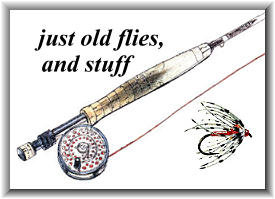The Shannon is named for the Shannon river
in Ireland, in the same way that many other
Salmon flies are named for home rivers, the
Namson (The Namson), the Helmsdale (The
Helmsdale Doctor), the Laxon (The Laxon), the
Ballyshannon (The Ballyshannon), the Test (The
Silver Test ) , the Wye (The Wye Grub) and the
Usk (The Usk Grub).
The Shannon fly is quite challenging
to tie, and not the least of the challenges is
finding the correct materials. While some
substitution can be done, goose for the scarlet
ibis, various feathers for the purple lory, the
main wing of Macaw covert feathers cannot be
duplicated using other feathers.
The pattern tied here is from Francis Francis,
who procured the fly from William Blacker. Blacker
was one of the old masters from the early part of the 19th
century. Blacker's book, Fly Making, Angling
& Dying (1855), does not include this
pattern. He includes the Ballyshannon as a fly
to fish the river Shannon, rather than its namesake.
This is surprising given the beauty of the Shannon
Salmon fly.
The fly pictured here is very close to the original
Francis Francis recipe. Fairy Blue Bird was
substituted for the purple lory, and goose for
the ibis, but beyond that the materials are
nearly as specified. It is quite difficult to
find puce colored hackle and floss, as the
original Veniard dye recipe has been lost. In
desperation I turned to Walmart, and found some
DMC floss very close to puce I think. I dyed the
hackle myself to match. Desperate times call for
desperate measures. There are always two battles
to be fought with full dress Salmon flies, one
with the materials and one tying the fly. Here's
Francis Francis' recipe:
Recipe per Francis Francis
Tag: Gold tinsel and lemon yellow floss
(silver tinsel also used in some recipes, and
used here.)
Tail: Two toppings, scarlet ibis and blue
macaw.
Butt: Black ostrich herl.
Body: Of floss silk, in joints of various
colors, pale blue, orange, puce and pea green,
every joint being mounted by a turn of ostrich
herl, and over this a hackle of the same tint
as the joint.
Ribs: Gold thread wrapped on each joint
separately (I used silver tinsel.)
Throat: One or two golden pheasant rump
feathers.
Wings: Two bright yellow macaw feathers
with black streak down the center, a strip of
dark speckled Argus pheasant on either side, and
strips of tippet ditto; two or three large toppings
over all.
Sides: Two or three slips of ibis.
Cheeks: Small feathers of purple lorry
(a Polynesian parrot).
Horns: Blue macaw ribs.
Head: Black.
~ Eric Austin
Credits: Classic Salmon Flies History &
Patterns by Mikael Frodin.
|

